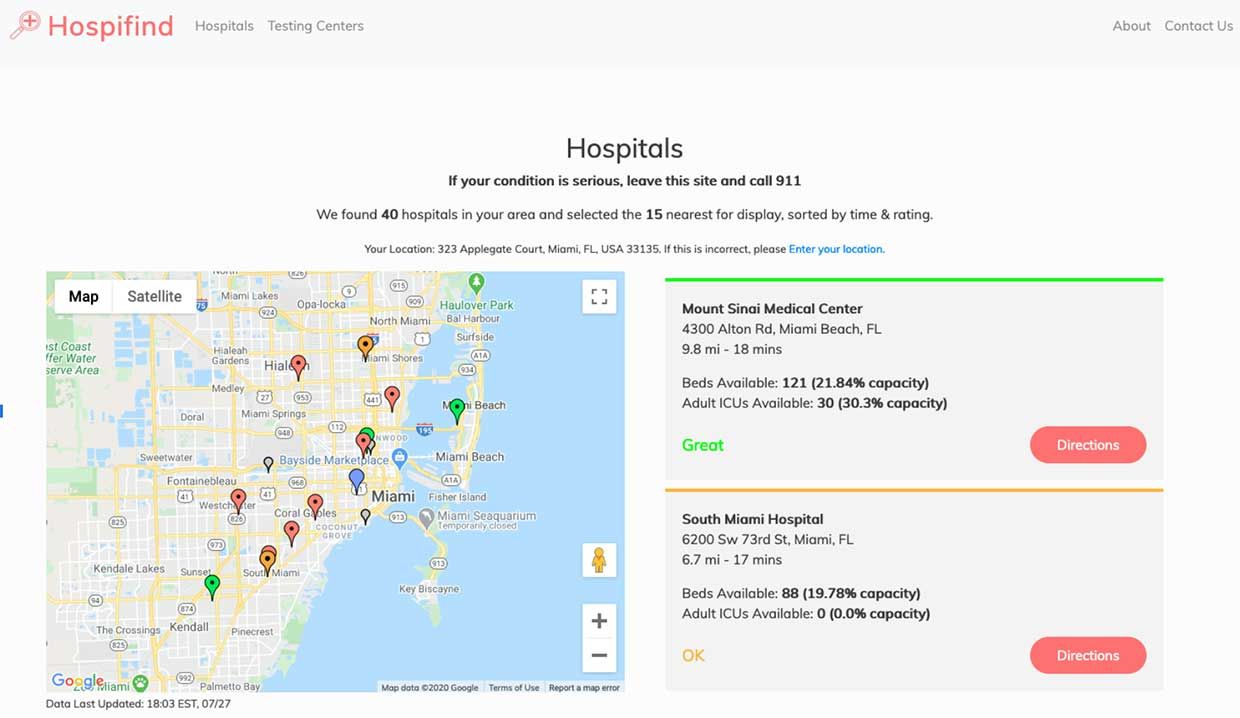A Central Repository For U.S. COVID-19 Testing Sites and Hospitals Aims to Prevent Overcrowding

THE INSTITUTE In the United States, it can be frustrating to locate the nearest COVID-19 testing site as well as obtain information about its hours, whether a prescription is needed, or the wait time. It can be just as difficult if you are suffering from the virus and want to find a hospital that has available beds or room in their intensive care unit.
 The Hospifind team [clockwise from top left]: Ron Nachum, Arya Grayeli, Amrita Sahu, Pranav Mathur, and Aarav Bajaj
The Hospifind team [clockwise from top left]: Ron Nachum, Arya Grayeli, Amrita Sahu, Pranav Mathur, and Aarav Bajaj That's because there's no central repository for each state that provides this kind of information. But an intrepid team of five high school students from Thomas Jefferson High School for Science and Technology, in Alexandria, Va., believes its Hospifind website could solve that problem. The students on the Hospifind team-Aarav Bajaj, Arya Grayeli, Pranav Mathur, Ron Nachum, and Amrita Sahu-are juniors at the school.
Nachum says the website is still a prototype and currently is only integrating real-time data from Florida's testing centers and hospitals.
The team's research advisor is Zoran Duric, an IEEE senior member and associate professor of computer science at George Mason University, in Fairfax, Va. Duric consulted with Nachum about Hospifind's development and mentored student in his biotechnology research, which Nachum presented at this year's IEEE Engineering in Medicine and Biology Conference, a virtual event held in July.
The Institute asked Nachum about the Hospifind project.
This interview has been edited and condensed for clarity.
What problem are you trying to solve?
Hospifind aims to optimally distribute patients among hospitals and testing centers during the COVID-19 pandemic to prevent overload and minimize stress on the health care system, ultimately saving the lives of patients and doctors.
We do this by aggregating data and providing ratings for hospitals and testing centers based on travel time and resource availability.
What technologies and software are you using?
Our Web application is hosted on Amazon Web Services, which we use for all computing and secure storage of our data in a cloud database. Our classification models vary based on available data, primarily utilizing decision trees and reinforcement learning classifiers to rate hospitals and testing centers based on travel time and resource availability.
Explain how your website works.
Users seeking general care can [view] nearby hospitals displayed on a map [shown below]. [The hospitals] are given ratings based on their current capacity and the patient's personal estimated travel time. [Users] can click on any hospital to get directions. We aggregate hospital data by scraping multiple government websites and store [that] information in a cloud database.
[Those] seeking COVID-19 tests can similarly see testing centers displayed on a map. They can also view additional information about a testing center including its wait time, whether the center is [a] walk-up or drive-through, and whether an appointment is required.
Users also have the ability to submit their wait time for a testing center, which we compile with other user-submitted wait times and display on the testing center results page. The more [people] we can get using this feature and testing centers we can get on board, the more we can really help [them] spend less time waiting for COVID-19 tests, decreasing turnaround times as well as the risk of disease spread in line.
 Image: Hospifind
Image: Hospifind How did you come up with this idea?
Hospifind started as a weekend hackathon app at the University of Virginia's annual HooHacks inspired by [newspaper] headlines reporting overloaded hospitals and long wait times for testing centers across the country. When the app won HooHacks' award for Best Health Hack, we realized it had the potential to aid in the nationwide battle against the COVID-19 pandemic. We saw this as a way to supplement the flatten the curve" initiative at the beginning of the pandemic by increasing health care capacity, and therefore raising the line" that represents resource availability on the widespread flatten the curve" graphic.
The team contacted health care professionals and researchers, including [my sister] Sapir Nachum, a medical resident in New York City's New York-Presbyterian Weill Cornell Medical Center, and Kathy Pham, a leader in healthcare technology with experience at, Google, IBM, and U.S. Digital Service. Pham provided mentorship during the early stages of Hospifind's development and gave feedback on initial models.
What challenges have you faced, and how did you overcome them?
One of the main challenges we faced during development was finding publicly available hospital and testing center capacity data. We were able to move past this issue by scraping the recently released hospital data on the Florida Coronavirus Community Dashboard and the state's Agency for Health Care Administration, and aggregating testing center wait-time data using a grassroots data collection system.
Our hope is that this proof-of-concept for Florida, with full functionality for both hospital data and testing center data, will help us gain enough credibility to pitch this solution to hospital administrators and governments across the country.
Currently the Hospifind database contains location and capacity data for hospitals across the country and testing centers in Florida. Data is updated every day for more than 150 hospitals, and we are working to expand this functionality to other highly impacted states. We have begun to [reach out] to testing centers in Florida, informing them of the application and encouraging their patients to enter wait times in the application. [More] than 60 Florida centers [are] currently supported. As we expand the database to include testing centers from the rest of the country, we will be able to better measure the impact of Hospifind on maintaining health care capacity across the country.
< Back to IEEE COVID-19 Resources